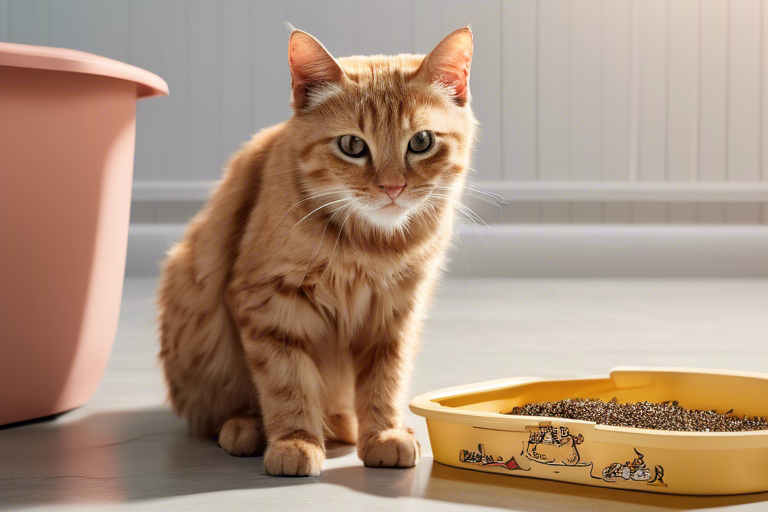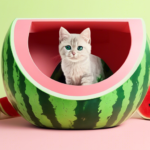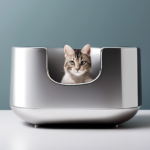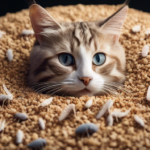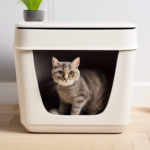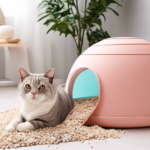Reasons Your Cat Is Peeing Over the Edge of the Litter Box: A Comprehensive Guide
Are you frustrated by your cat’s habit of peeing over the edge of the litter box? You’re not alone. This peculiar behavior can be perplexing and bothersome for cat owners. But fear not! In this comprehensive guide, we’ll delve into the depths of this issue and explore the various reasons why your cat may be exhibiting this behavior. By understanding the underlying causes, we can find solutions to help your cat get back on track.
Section 1: Medical Factors
Urinary Tract Infections
Urinary tract infections (UTIs) are a common medical condition that can cause cats to pee over the edge of the litter box. These infections occur when bacteria enter the urinary tract, leading to inflammation and discomfort. Cats with UTIs may experience pain or a burning sensation while urinating, which can make them associate the litter box with discomfort. The inflammation and irritation caused by UTIs can create a sense of urgency in cats, causing them to urinate more frequently and potentially outside the litter box.
Bladder Stones
The presence of bladder stones can also contribute to cats peeing over the edge of the litter box. Bladder stones are mineral accumulations that form in the bladder, causing discomfort and altering the cat’s normal elimination routine. These stones can irritate the bladder lining, leading to increased urgency and frequency of urination. Additionally, the presence of bladder stones can create a blockage or obstruction, making it harder for cats to fully empty their bladders and resulting in more frequent urination. Cats with bladder stones may experience pain or discomfort while urinating, which can lead them to associate the litter box with negative sensations.
Other Medical Issues
Various other medical conditions can contribute to cats peeing over the edge of the litter box. For example, diabetes mellitus, a metabolic disorder characterized by elevated blood sugar levels, can lead to increased urine production and excessive thirst in cats. This increased urine production can result in cats peeing over the edge of the litter box. Similarly, chronic kidney disease can affect a cat’s ability to concentrate urine and regulate hydration levels, leading to more frequent and larger amounts of urination. Cats suffering from arthritis may also experience joint pain and stiffness, making it uncomfortable for them to climb into or position themselves within the litter box.
It’s crucial to understand these medical factors and their impact on litter box behavior in order to identify potential underlying health issues. If you suspect any medical conditions as the cause of your cat’s inappropriate elimination, it’s essential to consult a veterinarian for proper diagnosis and treatment.
Section 2: Litter Box Size and Accessibility
Importance of Litter Box Size
The size of the litter box is an essential factor in ensuring cats have a comfortable and appropriate elimination experience. A litter box that is too small can pose challenges and may contribute to cats peeing over the edge. Cats have an instinctual need to dig and bury their waste, and a small litter box restricts their ability to perform these behaviors comfortably. This can lead to frustration and potentially inappropriate elimination outside the box.
Accessibility Challenges
The accessibility of the litter box is another crucial aspect to consider when addressing cats peeing over the edge. Difficult entry or high-sided litter boxes can make it challenging for cats to enter and exit the box comfortably. Cats prefer easy access to the litter box to maintain a sense of safety and security during elimination. If the entryway is too high or narrow, it can create a barrier for some cats, leading to avoidance or accidents. Older cats or those with mobility issues, such as arthritis, may struggle with litter boxes that require jumping or climbing, resulting in decreased litter box usage and potential accidents.
To address these challenges, it’s important to choose a litter box size and design that suits your cat’s needs and preferences. Providing a spacious and easily accessible litter box can encourage proper elimination behavior and reduce the likelihood of cats peeing over the edge.
Considerations for Choosing the Right Litter Box
When selecting a litter box, there are several factors to consider:
Size
Opt for a litter box that allows your cat to comfortably move, turn around, and dig without feeling constrained. A larger size will provide more space for your cat to eliminate without feeling cramped.
Entryway
Ensure that the entry is low enough for easy access, especially for kittens, older cats, or cats with physical limitations. A low entryway reduces the barrier for cats and encourages them to use the litter box comfortably.
Sides
Choose a litter box with appropriate side height that prevents litter spillage while still allowing easy entry and exit for your cat. The sides should be high enough to contain litter but not so high that they deter your cat from using the box.
By understanding the importance of litter box size and accessibility, you can create a more inviting and user-friendly environment for your cat. This, in turn, can help address the issue of cats peeing over the edge of the litter box and promote proper litter box usage.

Section 3: Litter Box Placement and Privacy
The placement of the litter box plays a significant role in determining a cat’s comfort and preference when it comes to elimination. Cats are naturally cautious animals and prefer a safe and secure environment for their litter box activities. Therefore, the location of the litter box can greatly influence their behavior.
Quiet and Secluded Area
Place the litter box in a calm and quiet part of the house, away from loud noises or disturbances. This provides a peaceful environment where your cat can feel comfortable while eliminating.
Accessible but Private
Ensure that the litter box is easily accessible for your cat but also provides a degree of privacy. Avoid placing it in open areas or near household appliances that may startle or disturb your cat during their litter box routine.
Lack of Privacy
Cats are inherently private animals, and a lack of privacy in the litter box area can lead to cats seeking alternative elimination spots, including peeing over the edge of the litter box. It’s important to understand and cater to their need for privacy to maintain proper litter box habits.
When cats feel exposed or vulnerable during elimination, they may feel the need to find a more secluded and secure spot to maintain their privacy. A lack of privacy can also lead to increased stress and anxiety in cats, which can further contribute to inappropriate elimination behaviors. Providing a private and serene environment for your cat’s litter box can help alleviate their anxiety and promote consistent litter box usage.
Section 4: Litter Box Cleanliness and Maintenance
The cleanliness of the litter box is vital for your cat’s hygiene and overall litter box usage. Cats are known for their cleanliness and prefer a clean and odor-free environment. Therefore, maintaining a clean litter box is essential to ensure your cat’s comfort and encourage proper elimination habits.
A dirty litter box can deter cats from using it. Cats have a highly developed sense of smell and can be sensitive to odors. If the litter box is dirty or has a strong odor, cats may seek alternative elimination spots. Additionally, a dirty litter box can create a breeding ground for bacteria, leading to urinary tract infections and other health issues in cats.
To maintain a clean litter box:
- Scoop the litter box at least once a day to remove waste.
- Replace the litter regularly to keep it fresh.
- Clean the litter box with mild, unscented soap and water on a regular basis.
- Avoid using harsh cleaning products or strong-smelling disinfectants, as they may deter cats from using the litter box.
By ensuring the cleanliness and maintenance of the litter box, you provide a hygienic and inviting environment for your cat to eliminate, reducing the likelihood of them peeing over the edge.
Section 5: Stress and Anxiety
Stressors in a cat’s environment can significantly impact their litter box habits. Identifying common stress triggers and understanding how they can lead to inappropriate elimination behavior is crucial.
Major changes like moving houses or introducing new pets can induce stress and anxiety in cats, resulting in litter box issues. Cats are creatures of habit and thrive on routine. Any disruption to their environment can cause them to feel anxious and unsettled, leading to changes in their elimination behavior.
To minimize stress and create a calm environment for your cat:
- Maintain a consistent routine for feeding, playtime, and litter box cleaning.
- Provide hiding places or elevated perches where your cat can retreat to when they feel overwhelmed.
- Use pheromone diffusers or sprays to create a calming atmosphere.
- Provide mental and physical stimulation through interactive toys and play sessions.
- Ensure that your cat has access to a quiet and safe space where they can relax and unwind.
By reducing stress and anxiety, you can help your cat feel more comfortable and secure, which can ultimately improve their litter box habits.
Section 6: Multi-Cat Dynamics and Litter Box Sharing
Conflicts among multiple cats can affect litter box usage. Cats are territorial animals, and the presence of other cats can lead to tension and competition for resources, including the litter box.
Understanding the territorial dynamics that can lead to cats peeing over the edge is essential. Cats may resort to this behavior as a means of asserting dominance or marking their territory. It’s crucial to address these issues and find ways to manage multi-cat litter box challenges.
Here are some strategies to promote harmony among multiple cats:
- Provide multiple litter boxes to ensure each cat has access to their own designated elimination area.
- Place litter boxes in separate locations to reduce competition and allow each cat to have their private space.
- Clean litter boxes regularly to prevent buildup and minimize odor-related territorial disputes.
- Use pheromone diffusers or sprays to create a calming environment and reduce tension among cats.
- Monitor interactions between cats and intervene if any aggressive behaviors or territorial disputes arise.
By addressing multi-cat dynamics and providing appropriate resources, you can reduce litter box conflicts and encourage proper elimination behavior.
Section 7: Litter Substrate Preferences
Just like humans, cats have individual preferences when it comes to litter substrates. Some cats may be sensitive to certain textures or materials and may avoid using the litter box if they find it uncomfortable or unpleasant.
To accommodate your cat’s litter substrate preferences:
- Experiment with different types of litter to find the one your cat prefers. This may include clumping litter, non-clumping litter, or alternative materials like wood pellets or recycled paper.
- Gradually transition your cat to a new litter type by mixing it with their current litter and gradually increasing the proportion of the new litter over time.
- Provide a variety of litter boxes with different substrates to cater to the preferences of multiple cats in a multi-cat household.
- Monitor your cat’s litter box usage and observe any changes in their behavior or preferences. Adjust the litter type accordingly to ensure their comfort and satisfaction.
By accommodating your cat’s litter substrate preferences, you can promote consistent litter box usage and reduce the likelihood of peeing over the edge.
Section 8: Additional Tips and Tricks
In addition to addressing the specific factors mentioned above, here are some general tips and tricks to help prevent your cat from peeing over the edge of the litter box:
- Maintain a consistent feeding schedule to regulate your cat’s bathroom routine.
- Provide plenty of fresh water to encourage proper hydration, which can help prevent urinary issues.
- Use litter box liners or protective mats to catch any litter or urine that may spill over the edge.
- Consider using a larger litter box or one with higher sides to contain any potential mess.
- Clean up any accidents promptly and thoroughly to remove odors and prevent re-marking.
- Consult with a veterinarian or animal behaviorist for further guidance and support if necessary.
By implementing these tips and tricks, you can create a conducive environment for your cat’s litter box habits and reduce the incidence of peeing over the edge.
Conclusion
Dealing with a cat that pees over the edge of the litter box can be frustrating, but by understanding the underlying reasons and implementing the appropriate solutions, you can help your cat get back on track. Remember to consider medical factors, ensure proper litter box size and accessibility, provide a clean and private environment, address stress and anxiety, manage multi-cat dynamics, and accommodate litter substrate preferences.
With patience, consistency, and a little extra effort, you can improve your cat’s litter box habits and create a cleaner and happier home for both you and your feline companion.
